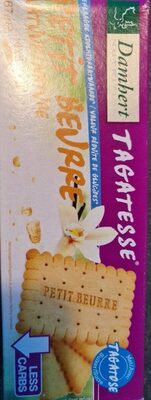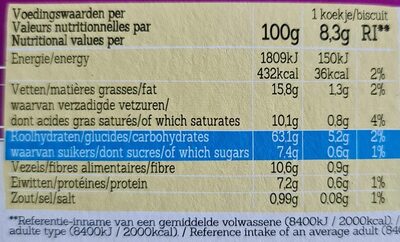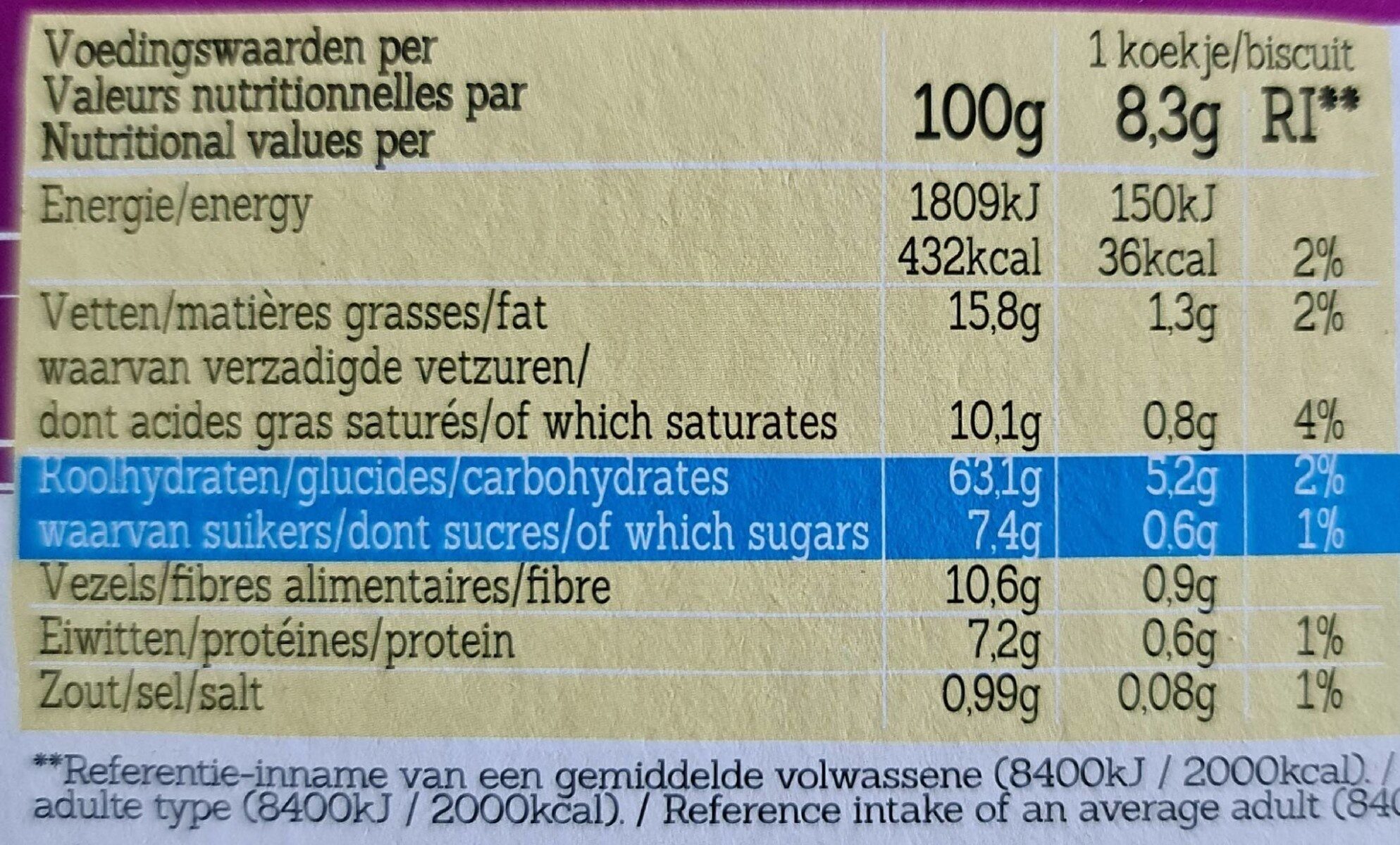Help us make food transparency the norm!
As a non-profit organization, we depend on your donations to continue informing consumers around the world about what they eat.
The food revolution starts with you!
Petit Beurre - Damhert - 167 g e
Petit Beurre - Damhert - 167 g e
This product page is not complete. You can help to complete it by editing it and adding more data from the photos we have, or by taking more photos using the app for Android or iPhone/iPad. Thank you!
×
Barcode: 5412158018977 (EAN / EAN-13)
Common name: Petit Beurre Nature avec Tagatose
Quantity: 167 g e
Packaging: Plastic, Box, Cardboard
Brands: Damhert
Categories: Snacks, Sweet snacks, Biscuits and cakes, Biscuits, Petit-Beurre
Labels, certifications, awards:
Green Dot, With sweeteners
Matching with your preferences
Health
Ingredients
-
22 ingredients
wheat flour, concentrated butter (14.5%), tagatose syrup [tagatose (34%), acidity regulator (hydrochloric acid)l fructo-oligosaccharides, wheat starch, rice starch, baking powders (ammonium carbonates, sodium carbonates, diphosphates), whole milk powder, emulsifier (mono - and diglycerides of fatty acids) salt, semi-skimmed milk, natural flavor (vanilla), sweetener (sucralose), contains naturally present sugars, ! may contain traces of egg, nuts, sesame seeds and soybeansAllergens: Eggs, Gluten, MilkTraces: Eggs, Nuts, Sesame seeds, Soybeans
Food processing
-
Ultra processed foods
Elements that indicate the product is in the 4 - Ultra processed food and drink products group:
- Additive: E450 - Diphosphates
- Additive: E471 - Mono- and diglycerides of fatty acids
- Additive: E955 - Sucralose
- Ingredient: Emulsifier
- Ingredient: Flavouring
- Ingredient: Sweetener
Food products are classified into 4 groups according to their degree of processing:
- Unprocessed or minimally processed foods
- Processed culinary ingredients
- Processed foods
- Ultra processed foods
The determination of the group is based on the category of the product and on the ingredients it contains.
Additives
-
E450 - Diphosphates
Diphosphates (E450) are food additives often utilized to modify the texture of products, acting as leavening agents in baking and preventing the coagulation of canned food.
These salts can stabilize whipped cream and are also found in powdered products to maintain their flow properties. They are commonly present in baked goods, processed meats, and soft drinks.
Derived from phosphoric acid, they're part of our daily phosphate intake, which often surpasses recommended levels due to the prevalence of phosphates in processed foods and drinks.
Excessive phosphate consumption is linked to health issues, such as impaired kidney function and weakened bone health. Though diphosphates are generally regarded as safe when consumed within established acceptable daily intakes, it's imperative to monitor overall phosphate consumption to maintain optimal health.
-
E471 - Mono- and diglycerides of fatty acids
Mono- and diglycerides of fatty acids (E471), are food additives commonly used as emulsifiers in various processed foods.
These compounds consist of glycerol molecules linked to one or two fatty acid chains, which help stabilize and blend water and oil-based ingredients. E471 enhances the texture and shelf life of products like margarine, baked goods, and ice cream, ensuring a smooth and consistent texture.
It is generally considered safe for consumption within established regulatory limits.
-
E500 - Sodium carbonates
Sodium carbonates (E500) are compounds commonly used in food preparation as leavening agents, helping baked goods rise by releasing carbon dioxide when they interact with acids.
Often found in baking soda, they regulate the pH of food, preventing it from becoming too acidic or too alkaline. In the culinary world, sodium carbonates can also enhance the texture and structure of foods, such as noodles, by modifying the gluten network.
Generally recognized as safe, sodium carbonates are non-toxic when consumed in typical amounts found in food.
-
E503 - Ammonium carbonates
Ammonium carbonate: Ammonium carbonate is a salt with the chemical formula -NH4-2CO3. Since it readily degrades to gaseous ammonia and carbon dioxide upon heating, it is used as a leavening agent and also as smelling salt. It is also known as baker's ammonia and was a predecessor to the more modern leavening agents baking soda and baking powder. It is a component of what was formerly known as sal volatile and salt of hartshorn.Source: Wikipedia
-
E507 - Hydrochloric acid
Hydrochloric acid: Hydrochloric acid is a colorless inorganic chemical system with the formula H2O:HCl. Hydrochloric acid has a distinctive pungent smell. It is mainly produced as a precursor to vinyl chloride for PVC. It is classified as strongly acidic and can attack the skin over a wide composition range, since the hydrogen chloride practically dissociates completely in solution. Hydrochloric acid is the simplest chlorine-based acid system containing water. It consists of hydrogen chloride and water, and a variety of other chemical species, including hydronium and chloride ions. It is an important chemical reagent and industrial chemical, used primarily in the production of polyvinyl chloride for plastic. In households, diluted hydrochloric acid is often used as a descaling agent. In the food industry, hydrochloric acid used as a food additive and in the production of gelatin. Hydrochloric acid is also used in leather processing. Hydrochloric acid was discovered by the alchemist Jabir ibn Hayyan around the year 800 AD. Hydrochloric acid was historically called acidum salis, muriatic acid, and spirits of salt because it was produced from rock salt and "green vitriol" -IronII sulfate- -by Basilius Valentinus in the 15th century- and later from the chemically similar common salt and sulfuric acid -by Johann Rudolph Glauber in the 17th century-. Free hydrochloric acid was first formally described in the 16th century by Libavius. Later, it was used by chemists such as Glauber, Priestley, and Davy in their scientific research. Unless pressurized or cooled, hydrochloric acid will turn into a gas if there is around 60% or less of water. Hydrochloric acid is also known as hydronium chloride.Source: Wikipedia
-
E955 - Sucralose
Sucralose: Sucralose is an artificial sweetener and sugar substitute. The majority of ingested sucralose is not broken down by the body, so it is noncaloric. In the European Union, it is also known under the E number E955. It is produced by chlorination of sucrose. Sucralose is about 320 to 1‚000 times sweeter than sucrose, three times as sweet as both aspartame and acesulfame potassium, and twice as sweet as sodium saccharin. Evidence of benefit is lacking for long-term weight loss with some data supporting weight gain and heart disease risks.It is stable under heat and over a broad range of pH conditions. Therefore, it can be used in baking or in products that require a long shelf life. The commercial success of sucralose-based products stems from its favorable comparison to other low-calorie sweeteners in terms of taste, stability, and safety. Common brand names of sucralose-based sweeteners are Splenda, Zerocal, Sukrana, SucraPlus, Candys, Cukren, and Nevella. Canderel Yellow also contains sucralose, but the original Canderel and Green Canderel do not.Source: Wikipedia
Ingredients analysis
-
May contain palm oil
Ingredients that may contain palm oil: Butterfat, E471
-
Non-vegan
Non-vegan ingredients: Butterfat, E963, E963, Whole milk powder, Semi-skimmed milkSome ingredients could not be recognized.
We need your help!
You can help us recognize more ingredients and better analyze the list of ingredients for this product and others:
- Edit this product page to correct spelling mistakes in the ingredients list, and/or to remove ingredients in other languages and sentences that are not related to the ingredients.
- Add new entries, synonyms or translations to our multilingual lists of ingredients, ingredient processing methods, and labels.
If you would like to help, join the #ingredients channel on our Slack discussion space and/or learn about ingredients analysis on our wiki. Thank you!
-
Non-vegetarian
Non-vegetarian ingredients: E963, E963Some ingredients could not be recognized.
We need your help!
You can help us recognize more ingredients and better analyze the list of ingredients for this product and others:
- Edit this product page to correct spelling mistakes in the ingredients list, and/or to remove ingredients in other languages and sentences that are not related to the ingredients.
- Add new entries, synonyms or translations to our multilingual lists of ingredients, ingredient processing methods, and labels.
If you would like to help, join the #ingredients channel on our Slack discussion space and/or learn about ingredients analysis on our wiki. Thank you!
-
Details of the analysis of the ingredients
We need your help!
Some ingredients could not be recognized.
We need your help!
You can help us recognize more ingredients and better analyze the list of ingredients for this product and others:
- Edit this product page to correct spelling mistakes in the ingredients list, and/or to remove ingredients in other languages and sentences that are not related to the ingredients.
- Add new entries, synonyms or translations to our multilingual lists of ingredients, ingredient processing methods, and labels.
If you would like to help, join the #ingredients channel on our Slack discussion space and/or learn about ingredients analysis on our wiki. Thank you!
: farine de blé, beurre concentré 14.5%, de tagatose, tagatose 34%, régulateur d'acidité (acide chlorhydrique), l fructo-oligosaccharides, amidon de blé, amidon de riz, poudres à lever (carbonates d'ammonium, carbonates de sodium, diphosphates), lait entier en poudre, émulsifiant (mono- et diglycérides d'acides gras), sel, lait demi-écrémé, arôme naturel de vanille, édulcorant (sucralose), Contient des sucres naturellement présents- farine de blé -> en:wheat-flour - vegan: yes - vegetarian: yes - ciqual_proxy_food_code: 9410
- beurre concentré -> en:butterfat - vegan: no - vegetarian: yes - from_palm_oil: maybe - ciqual_food_code: 16401 - percent: 14.5
- de tagatose -> en:e963 - vegan: no - vegetarian: no
- tagatose -> en:e963 - vegan: no - vegetarian: no - percent: 34
- régulateur d'acidité -> en:acidity-regulator
- acide chlorhydrique -> en:e507 - vegan: yes - vegetarian: yes
- l fructo-oligosaccharides -> fr:l-fructo-oligosaccharides
- amidon de blé -> en:wheat-starch - vegan: yes - vegetarian: yes - ciqual_proxy_food_code: 9510
- amidon de riz -> en:rice-starch - vegan: yes - vegetarian: yes - ciqual_proxy_food_code: 9510
- poudres à lever -> en:raising-agent
- carbonates d'ammonium -> en:e503 - vegan: yes - vegetarian: yes
- carbonates de sodium -> en:e500 - vegan: yes - vegetarian: yes
- diphosphates -> en:e450 - vegan: yes - vegetarian: yes
- lait entier en poudre -> en:whole-milk-powder - vegan: no - vegetarian: yes - ciqual_food_code: 19021
- émulsifiant -> en:emulsifier
- mono- et diglycérides d'acides gras -> en:e471 - vegan: maybe - vegetarian: maybe - from_palm_oil: maybe
- sel -> en:salt - vegan: yes - vegetarian: yes - ciqual_food_code: 11058
- lait demi-écrémé -> en:semi-skimmed-milk - vegan: no - vegetarian: yes - ciqual_proxy_food_code: 19041
- arôme naturel de vanille -> en:natural-vanilla-flavouring - vegan: yes - vegetarian: yes
- édulcorant -> en:sweetener
- sucralose -> en:e955 - vegan: yes - vegetarian: yes
- Contient des sucres naturellement présents -> fr:contient-des-sucres-naturellement-presents
Nutrition
-
Poor nutritional quality
⚠ ️Warning: the amount of fruits, vegetables and nuts is not specified on the label, it was estimated from the list of ingredients: 0This product is not considered a beverage for the calculation of the Nutri-Score.
Positive points: 5
- Proteins: 4 / 5 (value: 7.3, rounded value: 7.3)
- Fiber: 5 / 5 (value: 16.2, rounded value: 16.2)
- Fruits, vegetables, nuts, and colza/walnut/olive oils: 0 / 5 (value: 0, rounded value: 0)
Negative points: 20
- Energy: 5 / 10 (value: 1807, rounded value: 1807)
- Sugars: 1 / 10 (value: 7.4, rounded value: 7.4)
- Saturated fat: 10 / 10 (value: 10.1, rounded value: 10.1)
- Sodium: 4 / 10 (value: 396, rounded value: 396)
The points for proteins are not counted because the negative points are greater or equal to 11.
Nutritional score: (20 - 5)
Nutri-Score:
-
Nutrient levels
-
Fat in moderate quantity (15.8%)
What you need to know- A high consumption of fat, especially saturated fats, can raise cholesterol, which increases the risk of heart diseases.
Recommendation: Limit the consumption of fat and saturated fat- Choose products with lower fat and saturated fat content.
-
Saturated fat in high quantity (10.1%)
What you need to know- A high consumption of fat, especially saturated fats, can raise cholesterol, which increases the risk of heart diseases.
Recommendation: Limit the consumption of fat and saturated fat- Choose products with lower fat and saturated fat content.
-
Sugars in moderate quantity (7.4%)
What you need to know- A high consumption of sugar can cause weight gain and tooth decay. It also augments the risk of type 2 diabetes and cardio-vascular diseases.
Recommendation: Limit the consumption of sugar and sugary drinks- Sugary drinks (such as sodas, fruit beverages, and fruit juices and nectars) should be limited as much as possible (no more than 1 glass a day).
- Choose products with lower sugar content and reduce the consumption of products with added sugars.
-
Salt in moderate quantity (0.99%)
What you need to know- A high consumption of salt (or sodium) can cause raised blood pressure, which can increase the risk of heart disease and stroke.
- Many people who have high blood pressure do not know it, as there are often no symptoms.
- Most people consume too much salt (on average 9 to 12 grams per day), around twice the recommended maximum level of intake.
Recommendation: Limit the consumption of salt and salted food- Reduce the quantity of salt used when cooking, and don't salt again at the table.
- Limit the consumption of salty snacks and choose products with lower salt content.
-
-
Nutrition facts
Nutrition facts As sold
for 100 g / 100 mlCompared to: Petit-Beurre Energy 1,807 kj
(432 kcal)-8% Fat 15.8 g -13% Saturated fat 10.1 g -11% Carbohydrates 63.1 g -7% Sugars 7.4 g -73% Fiber 16.2 g +493% Proteins 7.3 g +3% Salt 0.99 g +36% Fruits‚ vegetables‚ nuts and rapeseed‚ walnut and olive oils (estimate from ingredients list analysis) 0 % Tagatose 4 g
Environment
-
Eco-Score B - Low environmental impact
⚠ ️Select a country in order to include the full impact of transportation.The Eco-Score is an experimental score that summarizes the environmental impacts of food products.→ The Eco-Score was initially developped for France and it is being extended to other European countries. The Eco-Score formula is subject to change as it is regularly improved to make it more precise and better suited to each country.Life cycle analysis
-
Average impact of products of the same category: A (Score: 82/100)
Category: Butter biscuit (cookie)
Category: Butter biscuit (cookie)
- PEF environmental score: 0.26 (the lower the score, the lower the impact)
- including impact on climate change: 2.22 kg CO2 eq/kg of product
Stage Impact Agriculture
74.1 %Processing
15.7 %Packaging
4.3 %Transportation
4.1 %Distribution
1.9 %Consumption
0.0 %
Bonuses and maluses
-
Missing origins of ingredients information
Malus: -5
⚠ ️ The origins of the ingredients of this product are not indicated.
If they are indicated on the packaging, you can modify the product sheet and add them.
If you are the manufacturer of this product, you can send us the information with our free platform for producers.
-
Packaging with a medium impact
Malus: -11
Shape Material Recycling Impact Box Plastic High Unknown Cardboard Low ⚠ ️ The information about the packaging of this product is not sufficiently precise (exact shapes and materials of all components of the packaging).⚠ ️ For a more precise calculation of the Eco-Score, you can modify the product page and add them.
If you are the manufacturer of this product, you can send us the information with our free platform for producers.
Eco-Score for this product
-
Impact for this product: B (Score: 66/100)
Product: Petit Beurre - Damhert - 167 g e
Life cycle analysis score: 82
Sum of bonuses and maluses: -16
Final score: 66/100
-
Carbon footprint
-
Equal to driving 1.2 km in a petrol car
222 g CO² per 100g of product
The carbon emission figure comes from ADEME's Agribalyse database, for the category: Butter biscuit (cookie) (Source: ADEME Agribalyse Database)
Stage Impact Agriculture
78.6 %Processing
9.8 %Packaging
5.0 %Transportation
5.8 %Distribution
0.9 %Consumption
0.0 %
Packaging
-
Packaging with a medium impact
-
Packaging parts
Box (Plastic)
(Cardboard)
-
Packaging materials
Material % Packaging weight Packaging weight per 100 g of product Paper or cardboard Plastic Total
-
Transportation
-
Origins of ingredients
Missing origins of ingredients information
⚠ ️ The origins of the ingredients of this product are not indicated.
If they are indicated on the packaging, you can modify the product sheet and add them.
If you are the manufacturer of this product, you can send us the information with our free platform for producers.Add the origins of ingredients for this product Add the origins of ingredients for this product
Report a problem
-
Incomplete or incorrect information?
Category, labels, ingredients, allergens, nutritional information, photos etc.
If the information does not match the information on the packaging, please complete or correct it. Open Food Facts is a collaborative database, and every contribution is useful for all.
Data sources
Product added on by openfoodfacts-contributors
Last edit of product page on by ecoscore-impact-estimator.
Product page also edited by beniben, inf, kiliweb, moon-rabbit, packbot, vicverbist, yuka.LZVYEf-BNfU8TN-JgdkO7CilMOvgD95YImQvog, yuka.WUtrbEVxMG91L01Kb3NRRXpFTHlxK2drOXE2TkJuTytGTG9USVE9PQ, yuka.XI16BMKkQeoQO_b1ibAQ_yiUKsXEGdlZJUMvow, yuka.sY2b0xO6T85zoF3NwEKvlmt_eNb6nyOYFz7kkneF-c_eDZDkUI5M-qH9I6s, yukafix.










